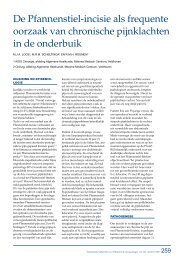Surgical management of chronic inguinal pain syndromes - Liespijn
Surgical management of chronic inguinal pain syndromes - Liespijn
Surgical management of chronic inguinal pain syndromes - Liespijn
You also want an ePaper? Increase the reach of your titles
YUMPU automatically turns print PDFs into web optimized ePapers that Google loves.
Cost-benefit analysisThe National Institute <strong>of</strong> Workers Benefit Compensation (The Netherlands: UWV) wasasked to make an approximation <strong>of</strong> the cost-benefit analysis. Firstly, the average yearlycosts for a person on workers’ compensation was calculated. Second, the yearly number<strong>of</strong> patients with severe postherniorrhaphy neuralgia applying for a workers benefitcompensation was estimated based on published data. From these numbers the totalcompensational costs in the Netherlands were calculated. The health care costs forneurectomy were approximated. Finally an estimating cost-benefit analysis forneurectomy and workers benefit costs was tabulated.RESULTSReview <strong>of</strong> the literatureWe analyzed the effects <strong>of</strong> operative and non-operative treatment for <strong>chronic</strong> postherniorrhaphy<strong>inguinal</strong> neuralgia. In total, 23 articles on operative neurectomy were identified12-19,22-35 . However, the effects on occupational disability after operative treatmentwas mentioned in just 4 studies 13,15,16,28 . The follow-up period ranged from 1 week to 60Author No Design Operation Follow-up Success rate on(months) occupational(range) disability (%)Heise 19 20 retrospective mesh removal 16 months 57% (4/7 patients)withor without (1 week -neurectomy60 months)Amid 16 225 prospective neurectomy IH, II 1 month (6 all patients exceptand/ or GF months by 4 returned to their worktelephone) (unclear how many)Vuilleumier 31 43 prospective Mesh removal, 12 months 100% (unspecified howalways neurectomymany patients involved)IH/II (GF neurectomyif indicated)Giger 18 34 prospective endoscopic 12 months 76% (16/21 patients)retroperitonealneurectomyTable 2 Previous studies on surgical <strong>management</strong> <strong>of</strong> postherniorrhaphy groin <strong>pain</strong> <strong>syndromes</strong> and effect onoccupational disability.months. There was only one retrospective study 13 . Amid et al. described by far the largestseries <strong>of</strong> 225 patients 15 . Type <strong>of</strong> treatment varied among studies. Giger et al. performeda neurectomy using an endoscopic retroperitoneal technique instead <strong>of</strong> an open anteriorapproach 15 . The number <strong>of</strong> resected nerves also differed among these studies. Vuilleumieret al. routinely performed a radical neurectomy <strong>of</strong> the iliohypogastric and ilio<strong>inguinal</strong>nerve 28 . Additional specifics are listed in table 2. Of all patients that were deemed unfitto properly work due to severe <strong>inguinal</strong> <strong>pain</strong>, 56 to 100% could resume their occupationalobligations after neurectomy.A small number <strong>of</strong> articles regarding non-surgical treatment options including peripheralnerve block, analgesics, TENS or PRF due to <strong>chronic</strong> postherniorrhaphy <strong>inguinal</strong> <strong>pain</strong>were identified 6-11 . The effect on occupational disability was usually ignored except inone case study describing a full regain <strong>of</strong> work after treatment with an implantableneurostimulator 8 . We found one surgical study suggesting that nerve blocks for <strong>inguinal</strong>neuralgia were more effective compared to neurectomy 25 . Twenty-two out <strong>of</strong> 24 patientswith postherniorrhaphy neuralgia were successfully treated with repetitive nerve blockswith Bupivacain and Methylprednisolon. However, no follow-up period nor effect onoccupational disability were mentioned.Tailored neurectomy54 patients received a tailored neurectomy as recently reported 18 . Of this population, 48patients could be contacted by telephone (response rate 89%). There were 36 males and11 females, and their mean age was 52±6 yrs (range 26 to 73).Figure 1 demonstrates a flow chart with respect to occupational disability. 20 patientswere excluded from further analysis because <strong>of</strong> the depicted reasons. Of the remaining28 patients, fifteen could continue their work uninterrupted despite their <strong>chronic</strong> <strong>pain</strong>,and the neurectomy did not alter their capacity to continue work activities. In contrast,13 patients were forced to discontinue their prior work due to the incapacitating <strong>chronic</strong><strong>pain</strong> syndrome. Most <strong>of</strong> these disabled patients (9/13, 70%) judged their work as physicallyheavy. Some were totally disabled (n=6) whereas others could only work part-time(n=7). After a successful neurectomy, 7 patients (54%) had fully resumed their old workinghabits without disability whereas 6 patients were still occupationally restricted.In a previously published questionnaire study, these 7 working patients had scored theirpostoperative results as ‘satisfactorily’. Results for the persistent disabled patients weregenerally poor.Cost-benefit analysisIn the Netherlands, a person on workers’ compensation will cost the society approximately€34.000 per year during the first 2 years. This number is composed <strong>of</strong> an averagesalary <strong>of</strong> €32.000 added with €2000 extra costs for replacement <strong>of</strong> personnel, loss <strong>of</strong>production etc (table 3). These benefits are paid by the employer. After this initial 2-year128 Chapter 9Occupational disability due to <strong>chronic</strong> postherniorrhaphy neuralgia: a plea for tailored neurectomy 129





